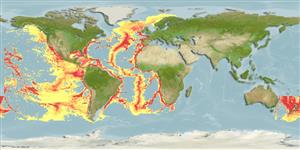Issue
More probably the larvae of a Notacanthus species after Smith (1989: Ref. 93804), of Notacanthus chemitzii Bloch, 1788 after Moser & Charter (1996: Ref. 35578). Confirmation work/publication still needed. Is uncertain in Notacanthidae in Eschmeyer (CofF ver. June 2013: Ref. 93641).
Environment: milieu / climate zone / depth range / distribution range
Ecologia
marino batidemersale. Deep-water
Circumglobal: Eastern Pacific: central California to Peru. Western Atlantic: Straits of Florida, Bahamas; Eastern Atlantic: off Gabon; Southwest Pacific: Chatham Islands, New Zealand.
Size / Peso / Age
Maturity: Lm ? range ? - ? cm
Life cycle and mating behavior
Maturità | Riproduzione | Deposizione | Uova | Fecundity | Larve
Oviparous.
Moser, H.G. and S.R. Charter, 1996. Notacanthidae: spinyeels. p. 82-85. In H.G. Moser (ed.) The early stages of fishes in the California Current Region. California Cooperative Oceanic Fisheries Investigations (CalCOFI) Atlas No. 33. 1505 p. (Ref. 35578)
IUCN Red List Status (Ref. 130435)
Threat to humans
Harmless
Human uses
Informazioni ulteriori
Age/SizeAccrescimentoLength-weightLength-lengthLength-frequenciesMorfometriaMorfologiaLarveDinamica popolazioni larvaliReclutamentoAbbondanzaBRUVS
BibliografiaAcquacolturaProfilo di acquacolturaVarietàGeneticaElectrophoresesEreditarietàMalattieElaborazioneNutrientsMass conversion
CollaboratoriImmaginiStamps, Coins Misc.SuoniCiguateraVelocitàModalità di nuotoArea branchialeOtolithsCervelliVista
Strumenti
Special reports
Download XML
Fonti Internet
Estimates based on models
Preferred temperature (Ref.
123201): 2.8 - 8.2, mean 4.3 °C (based on 1093 cells).
Phylogenetic diversity index (Ref.
82804): PD
50 = No PD50 data [Uniqueness, from 0.5 = low to 2.0 = high].
Bayesian length-weight: a=0.00102 (0.00046 - 0.00225), b=3.06 (2.88 - 3.24), in cm total length, based on all LWR estimates for this body shape (Ref.
93245).
Trophic level (Ref.
69278): 3.4 ±0.4 se; based on size and trophs of closest relatives
Resilienza (Ref.
120179): Molto basso, tempo minimo di raddoppiamento della popolazione più di 14 anni (Preliminary K or Fecundity.).
Fishing Vulnerability (Ref.
59153): Moderate vulnerability (42 of 100).
